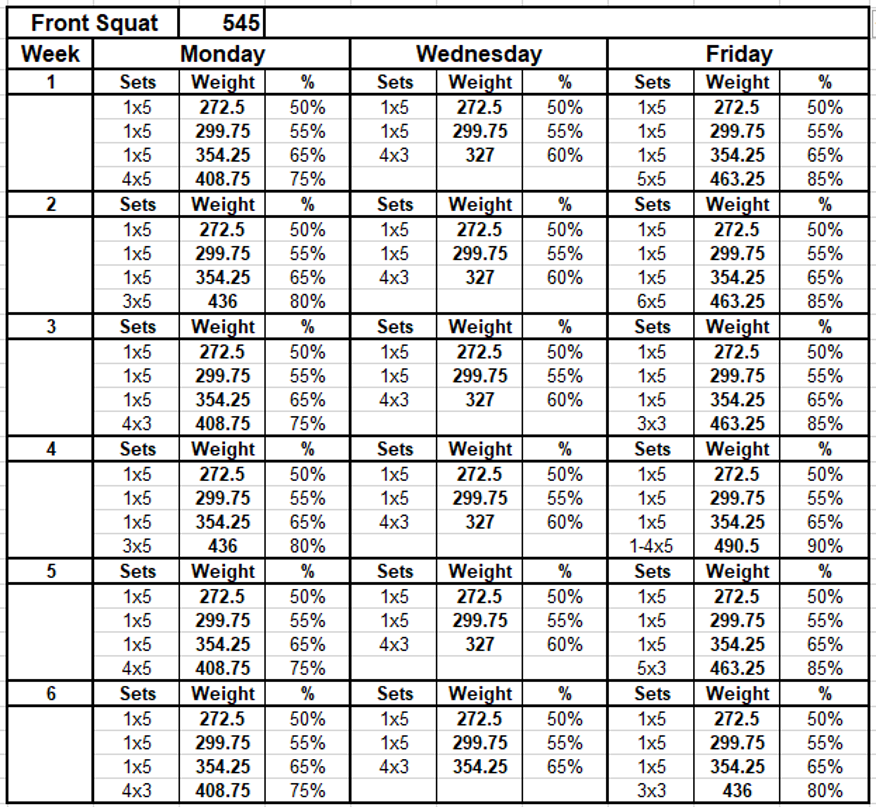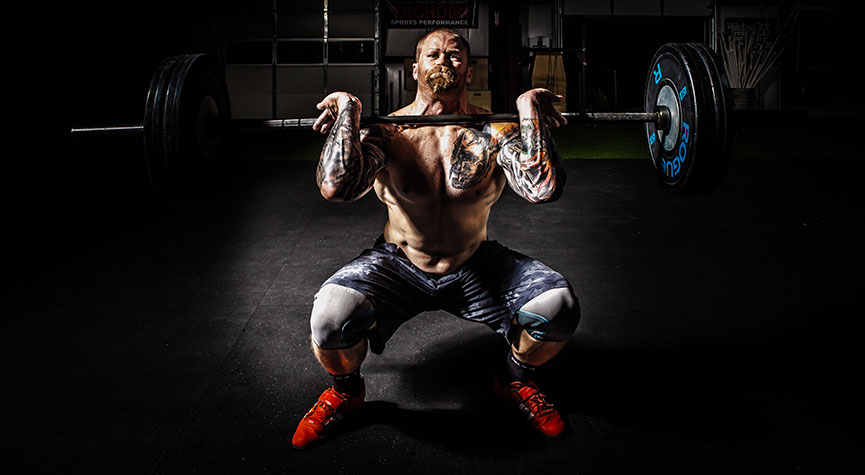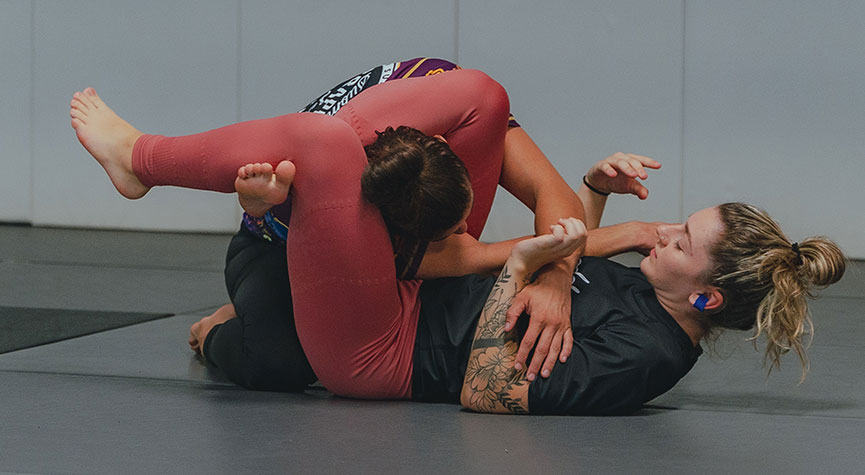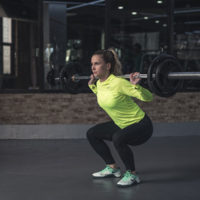As an athlete being as well-rounded as possible is key. Hall of Fame powerlifter Brad Gillingham is here to explain why the front squat is key your strength training regimen.
With more than 30 years of competitive lifting under his belt, Brad shares great life lessons and how the front squat has been an integral movement throughout his years of training.
The Hidden Tool
I made a commitment to include front squats (FS) into my off-season powerlifting training programs in the late 1990’s. A friend of mine, Scott Safe (Safe USA), created a 6-week training spreadsheet that he called the 1974 Soviet Union (Russian) Front Squat Program (RFSP). Scott was a national caliber powerlifter in the ADFPA in the 1980’s and 90’s. He eventually turned to coaching Olympic Weightlifting. There he developed the spreadsheet from a squat program he had read about in a well-known weightlifting publication. The original program contained two separate 3-week cycles that are run consecutively in a 6-week cycle. (See figure below.)
Leg development has always been a challenge of mine and at the time I was looking for something new to jump-start my off-season training. Then Scott convinced me that this could be the missing component that could move me to the top of the International Powerlifting Federation (IPF) Ranks. The RFSP surprisingly became the core element of my December through February training every year following IPF Worlds. I credit this training as a real key to my breakthrough IPF win in Akita City, Japan (2000). Not only did it strengthen my squat, but it also helped with my deadlift and bench press strength.
1974 Russian Front Squat Program
There are various Russian squat programs floating around. I have seen several variations of this program including a similar program that is called the 1976 Russian squat program. I believe sometimes things can get changed in translation, so I am sticking with calling this program the 1974 RFSP.
The program is similar in philosophy to other physically demanding high-volume Russian training programs like those developed by Russian powerlifting gurus Sergey Smolov and Boris Sheiko.
The RFSP includes a high volume of front squats (FS) performed three/days/week. The one change we made, to help with recovery, is that we placed the deloading session (4x3x60%), in between the two high intensity workouts.
The original program calls for two consecutive days of loading with a deload on the third day. In order to keep my back-squat strong, I would perform a progressively heavier double every Friday, prior to training the FS. All sets were done with no belt or supportive gear. My RAW back squat was always at its strongest following this training.
Why Front Squat?
The FS is a front-loaded quad dominate lift. In fact, the very nature of having to hold the weight in front of your shoulders forces you to squat in a more upright position than in a traditional low bar powerlifting squat. This forces the lifter to activate the quads more to complete the lift.
However, the FS is not only killer for the quads, but it also trains efficient back position, upper body strength, core strength, and powerful hip extension strength. There is research available that indicates that the FS provides greater glute activation than conventional deadlifts.1 Additionally, research indicates that the FS is effective in training the shoulder complex, scapula, and lower back.2
Incorporating this Workout for Non-Strength Sport Athletes
Competitive strength athletes may be leery of incorporating the RFSP into a training block due to the sheer volume of the program. However, I believe that most well trained athletes, looking to improve strength and power, can benefit from adding this program into their yearly training cycle.
We are fortunate in Southwest Minnesota to be located right in the middle of the Upper Midwest wrestling country. We always have several high school and collegiate wrestlers training with us at Jackals Gym during the summer.
Wrestling is a sport that requires both lower body, and upper body strength, power, and endurance. For example, maximum strength and explosive power is essential for the ability to take down an opponent.3 Additionally, I have found that there is no athlete more dedicated to getting stronger in the off-season than a wrestler.
The guys that lift at Jackals Gym are no exception. Most of them come in at 5:00 am to get done in time to get to their summer jobs. This past summer I decided to break up their training a little and have them repeat two rounds of the 6-week RFSP. In addition to front squatting, they also train a high volume of hang cleans, back squats, bench press, sandbags, sled push/pull, farmers walk and assistance. Yes…wrestlers are not afraid of a little work!
How to Incorporate FRSP into Your Training
Due to the volume of the RFSP it is not possible to train like this year around, and it is not designed for the beginning lifter. However, incorporating one or two phases of this program into an off-season training block can be beneficial for most well-trained athletes that depend on increasing strength.
Continued strength development depends on finding a way to train your weak areas. Don’t forget to include FS into your training program. Even if the RFSP is not for you, adding a few sets of FS to your training is a good way to mix things up and keep you from getting stalled in your training.
Stay Strong!
Brad Gillingham
Build Muscle and Get Stronger with myHMB
Training induces stress on the body and breaks down our muscles. Studies have shown myHMB promotes protein synthesis and decreases protein breakdown. These mechanisms of action allow your body to recover faster, improve strength, and build muscle. Learn more.
References:
- Korak JA, Paquette MR, Fuller DK, Caputo JL, Coons JM. Muscle activation patterns of lower-body musculature among 3 traditional lower-body exercises in trained women. Journal of Strength and Conditioning Research. 2018;32(10):2770-2775. View abstract.
- Baustista D, Durke D, Cotter JA, Escobar KE, Schick EE. A comparison of muscle activation among the front squat, overhead squat, back extension and plank. International Journal of Exercise Science. 2020;13(1):714-722. View abstract.
- Chaabene H, Negra Y, Bouguezzi R, et al. Physical and physiological attributes of wrestlers: An update. Journal of Strength and Conditioning Research. 2017;31(5):1411-1442. View abstract.
















